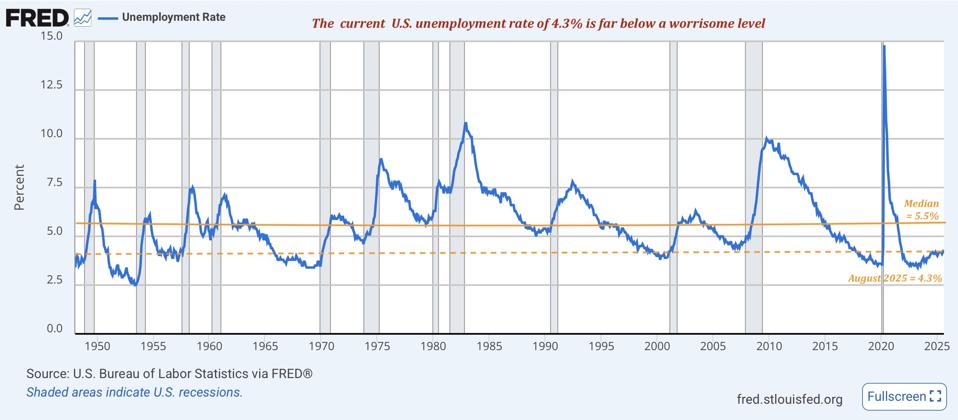The August unemployment level is up to 4.3%. However, that level remains a positive indicator. Why? Because it is well below the historical median level of 5.5%. A full 75% of all the post-World War II months had a higher unemployment level. The two graphs below show this historical comparison:
An easier way to see where the current unemployment rate stands is to sort all the months by size:
Why all the negative comments?
It is the latest item being used to push for lower interest rates. Here are four reasons why the reasoning is flawed:
First, the “historical” comparisons go back only a few years to the abnormally low unemployment caused by the Covid period’s sizable and unusual economic issues. Going back further undermines those comparisons. For a true reading of relative rates, we need to focus on the various past economic cycles.
Second, borrowers and Wall Street want lower interest rates. Look back to the 2020 and 2021 activities and speculation when the Federal Reserve kept rates low even as the money supply had a huge increase. They want those happy days to return. Therefore, there is cherry picking for negatives (like unemployment) to foster a desire for lower rates.
Third, the Federal Reserve’s “never again” promise as inflation shot up has worn out its welcome. As a result, banks are keeping savings and CD rates low because the Fed continues hinting at a reduction of its Federal Funds rate. And now President Trump has begun pushing for a fast reduction.
Fourth, the interest being paid by the U.S. Government climbed significantly not only by the increased deficit funding, but also by the Federal Reserve’ interest rate increases to fight inflation. It continues to climb as low-rate issues mature and new, higher rate issues are used to make the payments.
A serious fifth issue
The U.S. Government’s large deficits and borrowing have increased negative views. Also, President Trump’s disturbing of global relationships and trade has heightened the concern about the U.S. dollar’s desirability as a foreign reserve currency. Remember that if the dollar’s value falls versus other countries’ currencies, that is a loss of purchasing power (AKA, inflation).
Add in the tariffs’ price effects, plus the uncertainties created by the variability of President Trump’s tariff declarations, and both businesses and consumers must make adjustments. (For example, the increase in the August new car sales was credited to consumers jumping in as manufacturers hesitate to raise prices.)
The bottom line – Lower interest rates will not cure the serious issues
Lower rates will likely cause a false sense of optimism that, instead, will increase the problems. What is required is a pullback – on huge deficits, on aggravating international and internal relationships, and on the undermining of historical foundations of the United States.
Unfortunately, government leaders typically opt for low-probability actions that look positive over high-probability pullbacks that look negative.

